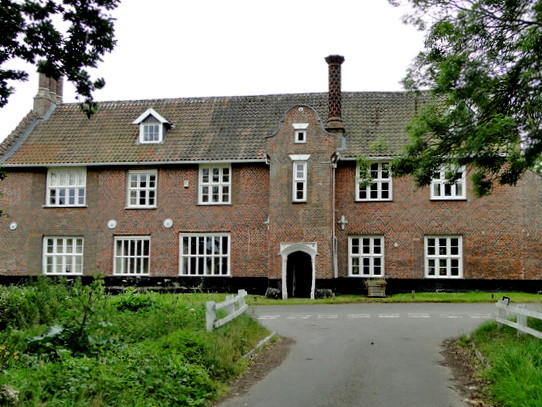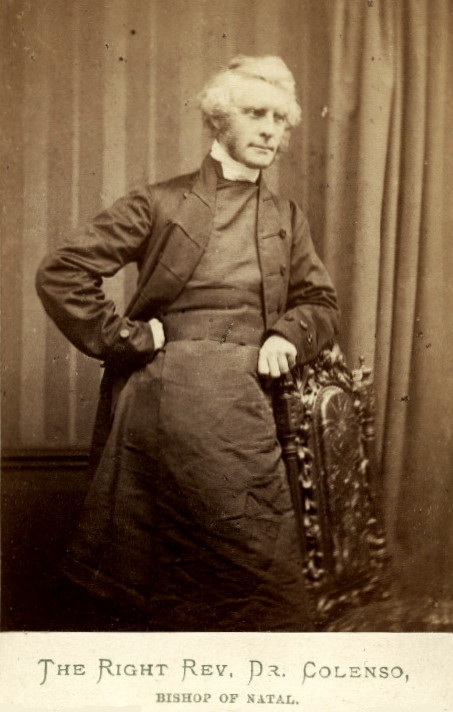
Rev. John William Colenso
Rev. John William Colenso
In 1846 a decision was made to appoint a separate rector for St. Mary's church. Until this time both St. Peter's and St. Mary's had shared the same rector. The new rector of St. Mary's was the Rev John William Colenso (1814-1883) who had already had a brilliant academic career as a mathematician at St. John's College, Cambridge. He also taught maths at Harrow School from 1838 to 1842.
Colenso married Sarah Frances Bunyon in London in January 1846. Sarah was the granddaughter of Thomas Bignold, the founder of the Norwich Union and she had met Colenso in 1842 when he was at Cambridge. It was Sarah who introduced Colenso to the work of the theologian Frederick Maurice, who became a friend and a major influence on Colenso's thinking.
When the couple arrived in Forncett later that year there was no rectory associated with St. Mary's church to accommodate them. So they lived at nearby Tharston Hall until a grand new rectory (now called 'Forncett Manor') was built, overlooking the church and the Tas Valley.

Tharston Hall where John and Sarah Colenso lived when they arrived in Forncett.
Colenso
and his family moved to the rectory in 1848/49 and the 1851 census lists fifteen
people living there. As well as Colenso, his wife and three children (Harriet,
Francis and Robert), there were four private boarders aged 15-19, the National
School mistress, and five servants. So, it would appear that Colenso was
offering private tuition alongside his work as rector of the parish. While living in Forncett, John Colenso edited a mission
journal and this brought him to the attention of Robert Gray, the Bishop of
Cape Town, when he was in England preparing to establish the diocese of Natal.
Gray invited Colenso to become its first Bishop.
John Colenso was consecrated on 30 November and immediately sailed to take up his duties in Natal. His aim was to spend a short time there, then return to England so that he could recruit helpers and also raise funds to carry out his vision for the missionary work. Returning to England as planned in 1854, he published Ten Weeks in Natal the following year. In early 1855 Colenso chartered the barque Jane Maurice to take him, his family and a group of helpers to Natal. They left Liverpool on 7th March but the voyage was very prolonged owing to wild weather, and in early April they docked in Trinidad! They finally sailed into Durban on the 20th May. Amongst Colenso's group were three of his parishoners from Forncett. William Alborough and two of his children, William and Jane. They were to go on to found "New Forncett" in Natal.
Colenso set up his official residence at Bishopstowe just outside Pietermaritzburg. He made a name for himself, and became financially secure, by writing standard mathematical textbooks, which were published by Longman.

Colenso's analysis of the Pentateuch (first five books of the Bible) questioned its authenticity and led to his being excommunicated by Bishop Gray of Capetown, a step which was challenged by Colenso. His challenge was upheld in England, but relations thereafter with the established church hierarchy, especially in South Africa, were fraught. The contentious matter was the prime mover in the commencement of Lambeth Conferences, the first 'Pan-Anglican Conference being in 1867, at which Archbishop Gray of Cape Town sought to have his deposition of Colenso confirmed; it was referred to a committee. His position in Pietermaritzburg was undermined by Bishop Gray, who had appointed another 'official' Bishop of Natal, thus splitting the Anglican Church in South Africa. Colenso also continued to court controversy by espousing the Zulu cause; they held him in high regard and called him 'Sobantu' (our father). Colenso spent long years pleading the cause of Chief Langalibalale. Colenso remained the Anglican Bishop of Natal until his death in 1883, and the cathedral church of St Peter's in Pietermaritzburg remained his official church (he is buried in front of the altar).

Colenso's home, Bishopstowe, in 1879. The house was burnt down in 1884.
His wife, Sarah, and daughters, Frances and Harriett, were inspired to follow his ideals even after his death. Bishopstowe has in recent years been restored from a derelict wreck to a research and teaching centre in his memory.
More details of the life and work of J W Colenso can be found in his Wikipedia entry.
Addendum: John William's cousin, William Colenso (1811 - 1899), was a little older than JWC and after serving an apprenticeship as a printer, emigrated to New Zealand, where he also served the Church Missionary Society as the printer in the Bay of Islands district, where he was responsible for the first printed biblical texts in Maori, as well as the Treaty of Waitangi in Maori. His principal hobby was botanizing; he did an enormous amount of recording of plants, sending details and specimens to Sir Joseph Dalton Hooker at Kew.
The initial material for this article was Forncett Archive Note No.13 - written by John Webster.
